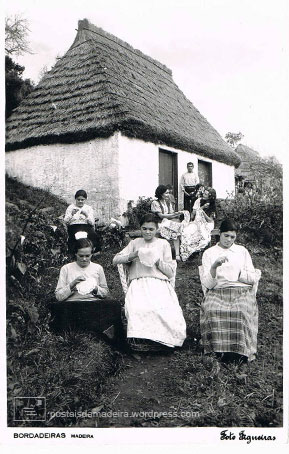By the hand of Elizabeth Phelps, born to an English family settled on the Island, Madeira Embroidery was introduced to the British and after the 2nd half of the 19th Century these works of art began to be recognized as merchandise for trade between Madeira Island and the outside world.
She began with a school where poor workers where taught how to embroider. Initially, their works were sold to family and friends but when they were introduced to the British market their success occurred rapidly.
 |
| Embroiderers dressing regional costumes, old postcard from here |
But with the growth of exportation, an enormous change in the fabrication process occurred: the designing and tracing phases went out of the hands of the embroiderers. The women living in the countryside received the fabric already prepared and then developed an extraordinary work of perfection with their agile and patient hands transforming the designed fabrics in unique works.
 |
| Madeira embroiderers gathered, photo from here |
Throughout the whole island, married and unmarried, old and young women were found together embroidering while talking about their lives and other’s lives…
But, as said before, embroidery in Madeira changed forever with Miss Phelps… As documented by popular oral tradition not only women knew the arts of needlework: Embroiders the father, embroiders the daughter, embroiders the mother… (popular verses)
 |
| Mother and daughter embroidering, image form this book |
Max, a famous Madeiran (born in the island), co-composed a song in honor of these women.
This is an old record, but we can hear in his voice with a strong Madeiran accent (I believe only Portuguese people can distinguish it..). Here you'll find a more recent version.
The lyrics says (talking about Madeira Island):
Like you there is no other
And in the dreamy nights
The waves foam is stitched
By the fingers of the embroiderers
In Portuguese (I made a very, very free translation...)
Como tu, não há nenhuma
e, nas noites sonhadoras,
Bordam das ondas a espuma,
Os dedos das bordadoras.




No comments:
Post a Comment